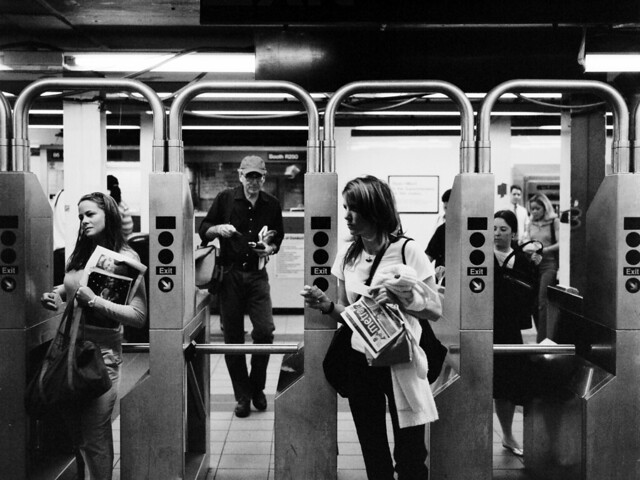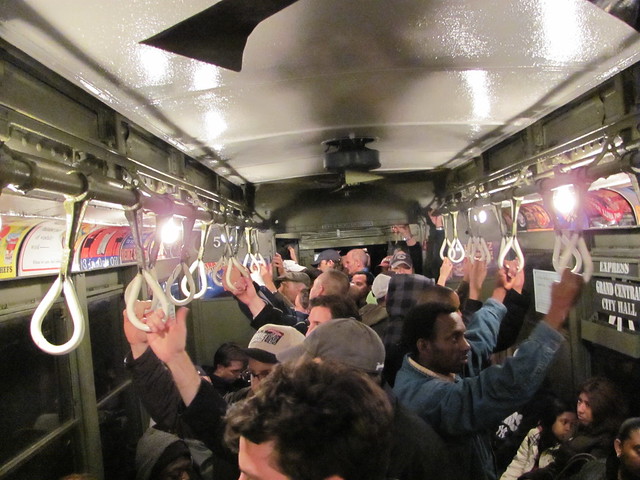
Four Turnstiles (1) by flickr user Infinite Jeff
Every day as I head into Manhattan and back home again, I have to navigate the southern entrance of the West 4th St. subway stop. Prior to February, the fare-control area was a madhouse. The two long walkways to the uptown and downtown platforms lead not to turnstiles but to an emergency exit on one side and a floor-to-ceiling fence on the other. It was a supreme waste of space and funneled people at the city’s 19th most popular station into a tight area.
Then, earlier this year, Transit rearranged the turnstiles. They added two turnstiles at the top of each exit ramp which allowed people to enter and exit the station without having to go out of the way and into that funnel of people. As Transit spokesman Paul Fleuranges said at the time, the changes “will provide better ingress and egress at the tops of the ramps, which currently doesn’t exist, thereby forcing customers to walk to the middle for both ingress and egress.”
After eight months, I can say conclusive that the changes almost work. Instead of seeing people crushed into an area with six turnstiles that lead directly to a wall, the two turnstiles on other end are used almost exclusively, and the ones in the middle are ignored. The changes have improved the flow of people only marginally because it has created a situation where people coming into the station and those coming out are jockeying for position at two turnstiles. It’s a swipe-eat-swipe world out there, and the person who dawdles while reaching for a MetroCard usually has to give way to someone charging out of the station. It isn’t an ideal set-up.
This past week, at CityRoom, The Times tackled subway improvements. Playing off of Transit’s renewed attention to its customers, the paper asked its readers to suggest ways in which the MTA could improve the customer experience. They ranged from the frequently discussed — eliminate the emergency exits — to the policy-oriented — require public elections for MTA Board positions — but one struck me as obvious. Said a reader with the initials JSL:
How about eliminating the two way turnstiles and subway entrances, and make them into one-way only entrances and one-way only exits (like in Paris)? Reduce the traffic jam created by people trying to go opposite directions on the staircases.
Another reader, Dennis DeMott, offered a similar suggestion:
How about something as simple as some pedestian traffic control at the busier/larger stations. A couple of signs or arrows painted on the floor so people keep to the right. Everyone is pretty used to things like barricades, up & down staircases and entrance/exit only turnstiles and most people will follow some simple rules if there are any in place. But there aren’t any! Right now it is a free for all.
It’s hard to find fault with these two ideas. Improving people flow is a key aspect to running a successful transit network, and the MTA doesn’t quite have this one under control. Riders block doors while straphangers waiting on platforms don’t allow those exiting to get off first. Heading up and down staircases can be treacherous as New Yorkers can’t seem to grasp the concept of walking on the right. Turnstiles move on a first-come, first-serve basis, and it isn’t unusual to see at a station with few turnstiles passengers trying to enter the system wait until the maddening crowd subsides before swiping in.
New Yorkers, the cliche goes, can’t be fenced in by rules and etiquette. We push forward no matter what. It might just be more pleasant for everyone though with a few one-way turnstiles and some suggestive arrows. If New Yorkers can be taught to move in an orderly fashion, a few turnstile bars to the gut might just be all the motivation we need.


















 (Rockaway Park Shuttle)
(Rockaway Park Shuttle)
 Every day, more than five million people swipe into the New York City subway system, and another two million take the bus. On a typical weekday, then, the equivalent of nearly everyone in New York City rides public transit, and while that figure may double-count a good number of people making the roundtrip to and from work or school, the fact remains that, without the subway system and its bus network, New York City would not be as prosperous, popular and big as it is today.
Every day, more than five million people swipe into the New York City subway system, and another two million take the bus. On a typical weekday, then, the equivalent of nearly everyone in New York City rides public transit, and while that figure may double-count a good number of people making the roundtrip to and from work or school, the fact remains that, without the subway system and its bus network, New York City would not be as prosperous, popular and big as it is today.